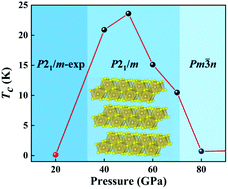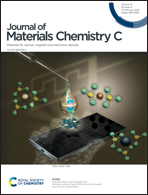Emergence of high superconductivity in a layered TaS3 crystal†
Abstract
Transition metal chalcogenides (TMCs) have attracted increasing attention due to their rich polymorphs and unique properties, i.e. pressure-induced superconductivity. In this work, we systematically investigated the phase diagram, stability, and superconducting properties of Ta–S systems under compression using the first-principles particle-swarm optimization algorithm and linear-response calculations for the electron–phonon coupling (EPC). Our results reveal a novel superconducting TaS3 structure with space group P21/m, which is characterized by layer stacking of eight-coordinated TaS8 hendecahedrons dynamically stable down to ambient conditions. Strikingly, due to the strong EPC with the constant λ ∼ 1.9, the new P21/m-TaS3 displays a critical temperature Tc of 23.6 K at a relatively low pressure of 50 GPa, which is the highest value ever found among the already reported TMCs. The high Tc primarily arises from the nested Fermi surface and the induced phonon softening in the P21/m-TaS3 structure. In addition, we find other stably superconducting Ta–S stoichiometries, P![[6 with combining macron]](https://www.rsc.org/images/entities/char_0036_0304.gif) m2, and Pm
m2, and Pm![[3 with combining macron]](https://www.rsc.org/images/entities/char_0033_0304.gif) m symmetry TaS, and I4/mcm Ta2S, but with a much lower Tc. Superconductivity in all these compounds can be attributed to the exotic pressure-induced softened phonon modes. Our findings, therefore, provide important information to further understand the intrinsic physics of pressure-driven behaviors in TMCs and related materials.
m symmetry TaS, and I4/mcm Ta2S, but with a much lower Tc. Superconductivity in all these compounds can be attributed to the exotic pressure-induced softened phonon modes. Our findings, therefore, provide important information to further understand the intrinsic physics of pressure-driven behaviors in TMCs and related materials.



 Please wait while we load your content...
Please wait while we load your content...